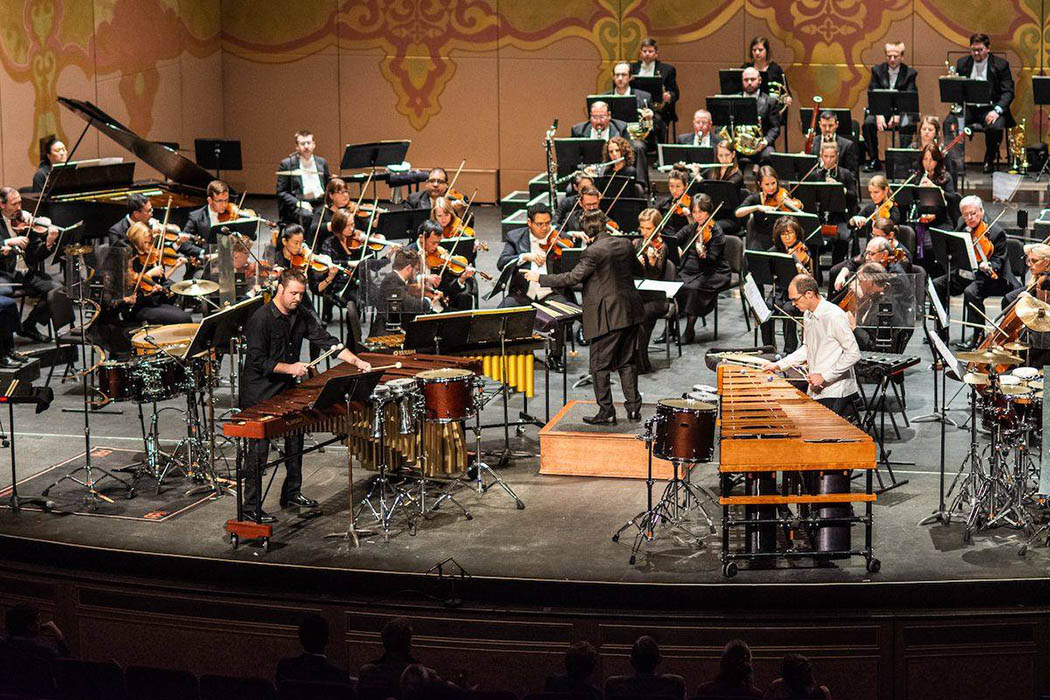While double bass players might argue to the contrary, it is an orchestral fact that percussionists—generally relegated to the back corner of the concert stage and, yet, responsible for a virtually infinite diversity of sounds—receive the least amount of attention, admiration, or acclaim for their performances compared to other sections of the orchestra. So, what happens when percussion moves to the front of the stage and takes on the role of soloist in a concerto? The Knoxville Symphony Orchestra found the answer to that question this weekend as the orchestra offered up a concert titled “Beethoven and the Art of Rhythm” that included the 2006 percussion concerto Spices, Perfumes, Toxins! by the Israeli composer Avner Dorman.
Joining the KSO for the Dorman work were two percussionists, Andy Bliss and Mike Truesdell, part of the contemporary music organization based in Knoxville, Nief-Norf. (Dr. Bliss is a founder of Nief-Norf and Director of Percussion Studies at the University of Tennessee’s School of Music; Dr. Truesdell is Assistant Professor of Percussion at Ithaca College in upstate New York.) Perhaps befitting the anonymity that percussionists have grown accustomed to—or feel obligated to assume—the duty of introducing them as individuals to the audience fell to KSO maestro Aram Demirjian.
The apparent modesty of percussionists aside, there was nothing modest about this performance of Spices, Perfumes, Toxins!. It is, in fact, a showcase piece that not only puts the solo focus on the qualities and mind-boggling variety of the percussion instruments involved—among them, marimbas, vibraphones, darbukas, tom toms, bells, bongos, and drum sets—but also on the energetic, virtuosic performances by Bliss and Truesdell.
In three movements as the title suggests, this quasi-impressionistic work opens with “Spices” a tapestry of sound played on two marimbas woven with Middle Eastern and Indian flavors and broken by various drum punctuations. The second section, “Perfumes”, contained a more wistful lyricism with hinted-at moments of Spanish flavor. The third movement, “Toxins!”, returned to an energetic tempo in which one felt a rhythmic combativeness that built to an explosive climax of sound. Admittedly, a percussion concerto of this nature offers all sorts of technical challenges. If there was an occasional downside to this evocative and virtuosic performance, it was a technical one of the dynamic balance from the orchestra’s textural support.
Bookending the percussive rhythms of Dorman’s concerto on the weekend’s Masterworks concerts were the orchestral rhythms of Ludwig van Beethoven, a composer being honored this year and next for the 250th anniversary of his birth. On this occasion, Demirjian opened with the Overture to The Creatures of Prometheus and concluded with the pulsing and exuberant Symphony No. 7. It’s worth noting that the Beethoven Seventh has figured prominently in Demirjian’s career, it being one of the works on his audition concert performed when he was vying for the KSO music directorship in January, 2016. [My review in the Knoxville Mercury: “KSO Braves a Winter Weather Scare to Kick Off 2016 Masterworks Concerts”].
It’s only natural, then, that maestro Demirjian feels an affection for the Beethoven Seventh, an emotion obviously shared by the orchestra players, and one that vigorously set the stage for what was one of the most dynamically sublime and nuanced performances that I have witnessed from the orchestra to date. Part of that affection displayed was the belief in energetic tempos and a crisp rhythmic drive that sets off the clever conversational banter, exquisitely accomplished with terrific ensemble-ness between the woodwinds, and supported by a similarly enchanting layering of string textures.
In the first movement, Poco sostenuto; Vivace, Demirjian established a pattern of diversity of dynamics that had a rhythm of its own through the ebb and flow of crescendo and decrescendo. The slightly slower second movement, Allegretto, carried on with this idea, but with phrases and variations that were the essence of non-narrative storytelling. Subtle humor marked the third Presto movement with delightful “burps” from the second horn played by Sean Donovan. The finale movement, Allegro con brio, was a masterpiece of movement, one that unabashedly presented itself with vibrance and infectious vitality.
The orchestra was equally crisp and compelling in the concert’s opener, Beethoven’s Overture to The Creatures of Prometheus, the composer’s one venture into the world of ballet.
While Beethoven has established himself for the ages, those that perform him must answer to the contemporary realities of ambition and the advancement of one’s career. In a temporary challenge to the KSO’s marvelous achievement of ensemble quality, it has been announced that two woodwind principals are moving to orchestras in larger metropolitan areas—principal flute Hannah Hammel, who played brilliantly on the Beethoven symphony, has taken the comparable position with the Detroit Symphony Orchestra; principal bassoon Aaron Apaza has taken the principal bassoon position with the North Carolina Symphony.






